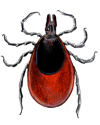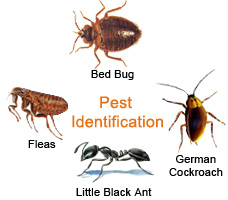We offer the best exterminating services in tri-state area which is New York, New Jersey and Connecticut.
Blacklegged Tick Common Name: Deer Ticks
 Blacklegged ticks are hard ticks which are orange-brown in color, except for the head. They are commonly found between fields and lower grassy vegetation (in transition areas), along animal trails, and in host animal nests and dens, like woodpiles, burrows in the ground, stumps, logs old rat and bird nests, and crawlspaces etc. They wait for host animals by climbing grass and shrubs.
Blacklegged ticks are hard ticks which are orange-brown in color, except for the head. They are commonly found between fields and lower grassy vegetation (in transition areas), along animal trails, and in host animal nests and dens, like woodpiles, burrows in the ground, stumps, logs old rat and bird nests, and crawlspaces etc. They wait for host animals by climbing grass and shrubs.
Habits
Blacklegged ticks are 1/16 to 1/8-inch in length. A female blacklegged tick is 1/16-inch long when unfed and its shield-like area remains unchanged. However, the rest of her body stretches and becomes darker as she sucks in blood while feeding. Blacklegged ticks do not have festoons (rectangular areas divided by grooves) along the posterior end of their abdomens. Adults have eight legs while the larvae have six and are 1/32-inch in length.
Their bodies are flat and shaped like a teardrop while their mouthparts can be easily seen when from above. These ticks are three-host ticks, meaning they need different and successively larger host animals for their complete growth. The larvae and adults commonly infest white-footed deer mice and deer, respectively, while the nymphs have a much wider range of hosts, including humans. They are responsible for transmitting Lyme disease.
The adults feed on deers in the winter. In spring, well fed females lay around 3,000 eggs, in 48 to 135 days. This is done in a protected area, after dropping off of the host animal. From June through September the larvae seek and feed on smaller rodents, such as mice, voles, and chipmunks. After molting to the nymphal stage, the ticks once again seek hosts. They feed only once for three to nine days on larger animals such as raccoons, opossums, and squirrels. Nymphs are found from April through August of the following season. After 25 to 56 days, engorged nymphs molt to the adult stage and go on to feed on deers. Growth from egg to adult normally takes two years which can extend up to four years, in the absence of suitable hosts. Adults live long enough to mate and for the female to lay eggs and then die.
How to Prevent Damage
- Avoid brushing against vegetation near gateways and other openings
- Be careful while sitting on stonewalls and other areas where smaller animals like squirrels, rabbits, opossums etc., frequent.
- A shower right after a walk in the woods may remove ticks as they do not bite their hosts immediately.
- Check crevices for these ticks in your house.
- Tick kits come handy after one is bitten.
- Use mouse traps.
- Call professionals if things go beyond your control.
We emphasize on using green methods to exterminate blacklegged ticks that are both very effective as well as environment friendly.
Roaches/Pests Control
Request Free Consultation
"The ants in my garden had really become a nuisance for me. When one of my friends told me about NYGreenEco, I called them to have a look on the garden and offer a solution. They cooked up a customized solution to help me get rid of the miscreants. The way they work is really amazing!"





